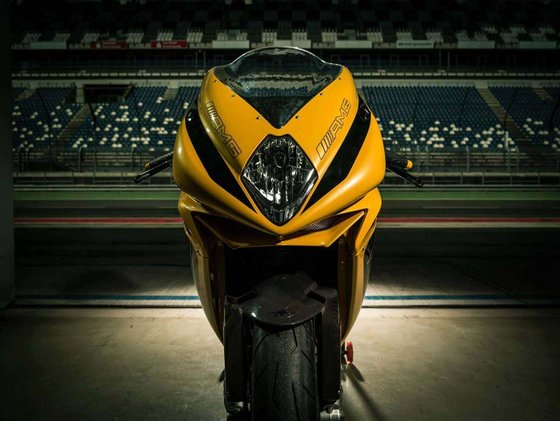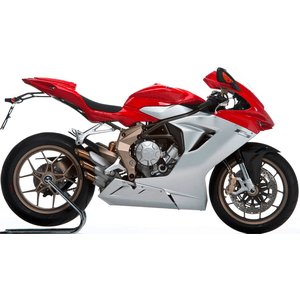MV Agusta F3 800 [2016–2019]: A Symphony of Italian Engineering

Introduction
The MV Agusta F3 800 isn’t just a motorcycle—it’s a declaration of intent. Born from a legacy of racing dominance and draped in the kind of Italian flair that makes even mundane commutes feel like laps at Mugello, this middleweight supersport redefined what it means to balance aggression with sophistication. From 2016 to 2019, the F3 800 stood as a testament to MV Agusta’s obsession with blending track-ready performance with road-going practicality. But does it live up to the hype? After spending time with this machine, the answer is a resounding yes—with caveats that only make the story richer.
Let’s dissect why this triple-cylinder marvel remains a benchmark in its class.
Design: Art Meets Aerodynamics

MV Agusta has always treated motorcycle design as high art, and the F3 800 is no exception. The sharp, angular fairings aren’t just for show—they channel air efficiently around the radiator and rider, while the exposed trellis frame serves as a visual reminder of the bike’s lightweight construction. The single-sided swingarm, a signature MV touch, adds a touch of mechanical theater every time you glance rearward.
Ergonomics: Sporty, But Not Sadistic
With a seat height of 805 mm (31.7 in), the F3 800 is accessible for riders of average height, though the aggressive riding position leaves no doubt about its track ambitions. The clip-ons are low, and the rearset pegs position your knees at a sharp angle—perfect for carving corners, less so for hour-long highway slogs. The tank’s narrow profile, however, makes it easy to grip with your thighs, offering stability under hard braking.
Color Schemes & Special Editions
The standard F3 800 came in understated hues like Matt Metallic Senna Black and Pearl Ice White/Matt Avio Grey, but limited editions like the F3 800 RC and AMG Collaboration model dialed up the drama with racing liveries, carbon fiber accents, and signed bodywork by MV Agusta’s factory riders. These variants weren’t just cosmetic upgrades—they often included performance tweaks like lighter exhausts and refined ECU maps.
Engine & Performance: The Soul of the Beast

The 798cc Inline Triple: A Masterclass
At the heart of the F3 800 lies a 798cc inline-three engine—a configuration that splits the difference between the raw torque of a twin and the frenetic top-end rush of a four-cylinder. With 148 hp at 13,000 rpm and 88 Nm (65 lb-ft) of torque at 10,600 rpm, this powerplant is as flexible as it is ferocious.
- Low-End Grunt: Unlike peaky 600cc supersports, the F3 800 pulls strongly from 5,000 rpm, making it viable for city riding.
- Midrange Surge: The real magic happens between 8,000–12,000 rpm, where the engine’s counter-rotating crankshaft (a trick borrowed from MotoGP) minimizes gyroscopic inertia, allowing quicker directional changes.
- Top-End Scream: Past 12,000 rpm, the exhaust note hardens into a metallic howl as the tachometer races toward the 13,500 rpm redline.
Transmission & Clutch
The 6-speed cassette-style gearbox is slick, though the mechanical slipper clutch requires a firm hand at the lever. Opt for the MV EAS 2.0 quickshifter, and upshifts become seamless, even at full throttle. Downshifts, however, demand precise rev-matching—a small price for the added engagement.
Electronics: Cutting-Edge, But Not Cold

The F3 800’s MVICS (Motor & Vehicle Integrated Control System) suite was revolutionary for its time, offering:
- Four Ride Modes (Sport, Normal, Rain, Custom)
- Eight-Level Traction Control (adjustable on the fly)
- Engine Brake Control (to fine-tune deceleration)
In practice, the system feels intuitive. Sport mode sharpens throttle response to a razor’s edge, while Rain mode softens power delivery and maximizes TC intervention. The real gem is Custom mode, where riders can tweak parameters like throttle sensitivity and torque delivery—a rarity in this segment.
Quirks & Refinements
Early models (2016–2017) occasionally suffered from abrupt throttle response in Sport mode, a flaw largely rectified by 2018’s Euro 4 updates. The Eldor EM2.0 ECU also allowed dealers to flash updated maps for smoother low-RPM behavior—a godsend for commuters.
Handling: Scalpel Sharp

Chassis Dynamics
The F3 800’s ALS steel trellis frame and aluminum swingarm pivot plates strike a perfect balance between rigidity and feedback. With a wheelbase of just 1,380 mm (54.3 in), the bike flicks into corners with telepathic ease. The Marzocchi 43mm USD fork and Sachs rear shock are fully adjustable, though stock settings err toward track stiffness—budget time (or a visit to MOTOPARTS.store for softer springs) if you plan to ride bumpy roads.
Brakes & Tires
Brembo M4.34 monobloc calipers bite down on 320mm discs with relentless force, aided by Bosch 9.1MP ABS. The system’s Rear Lift Mitigation is subtle, rarely intruding unless you’re trail-braking like a lunatic. Stock Pirelli Diablo Rosso Corsa tires provide ample grip, though serious track riders will appreciate an upgrade to slicks.
Competition: How Does It Stack Up?
The F3 800’s rivals were formidable, but each had compromises:
| Model | Pros | Cons | |---------------------|-------------------------------------------|-------------------------------------------| | Yamaha YZF-R6 | Rev-happy engine, bulletproof reliability | Anemic low-end torque, harsh ergonomics | | Triumph Daytona 675 | Lighter, sharper turn-in | Less power, dated electronics | | Ducati Panigale 959 | V-twin torque, stunning design | Heavier, higher seat height |
The F3 800’s ace card is its versatility. It lacks the R6’s track-focused intensity or the Panigale’s low-end grunt but combines the best traits of both into a package that’s equally at home on twisty backroads and circuit days.
Maintenance: Keeping the Triple Thrilling
Key Service Intervals
- Valve Clearances: Every 12,000 km (7,456 miles)—a labor-intensive job requiring shims.
- Oil Changes: Every 6,000 km (3,728 miles) with 10W-60 full synthetic.
- Chain Adjustment: Frequent checks recommended due to the high-torque engine.
Common Upgrades
- Exhaust Systems: Swap the stock muffler for a lightweight SC-Project slip-on (available at MOTOPARTS.store) to shed 3 kg and unlock a richer exhaust note.
- Suspension Tuning: Sachs shock preload adjusters simplify sag setup for riders of varying weights.
- Brake Pads: Brembo SC pads offer better bite for track use.
Reliability Notes
The F3 800 is generally robust, but watch for:
- Clutch Wear: Heavy use of the quickshifter can accelerate plate wear.
- Electronics Glitches: Early models benefit from ECU updates available at MV dealerships.
Conclusion: The Italian Paradox
The MV Agusta F3 800 is a study in contrasts. It’s a bike that demands your attention—not just because of its stratospheric performance, but because it refuses to let you ride passively. Every input matters, from the weight of your pinky finger on the brake lever to the subtle shift of your hips mid-corner. Yes, it’s less practical than a Japanese inline-four and more temperamental than a Ducati V-twin. But for riders who crave a machine that connects rather than merely transports, the F3 800 remains peerless.
In a world increasingly dominated by homogenized performance, the MV Agusta F3 800 is a reminder that passion still has a place on two wheels—and in our garage.
Looking to enhance your F3 800? Explore MOTOPARTS.store’s curated selection of upgrades, from performance exhausts to ergonomic tweaks. Because even perfection has room for improvement.
Specifications sheet
| Engine | |
|---|---|
| Stroke: | Four-stroke |
| Max power: | 109 kW | 146.0 hp |
| Max torque: | 88 Nm |
| Fuel system: | Integrated ignition-injection system MVICS with six injectors |
| Max power @: | 13000 rpm |
| Displacement: | 798 ccm |
| Max torque @: | 10600 rpm |
| Configuration: | Inline |
| Cooling system: | Liquid-cooled with separate radiators |
| Compression ratio: | 13.3:1 |
| Number of cylinders: | 3 |
| Valves per cylinder: | 4 |
| Dimensions | |
|---|---|
| Wheelbase: | 1380 mm (54.3 in) |
| Dry weight: | 173 |
| Seat height: | 805 mm (31.7 in) |
| Overall width: | 725 mm (28.5 in) |
| Overall height: | 1390 mm (54.7 in) |
| Overall length: | 2060 mm (81.1 in) |
| Ground clearance: | 125 mm (4.9 in) |
| Fuel tank capacity: | 16.6 L (4.3 US gal) |
| Reserve fuel capacity: | 5 L (1.3 US gal) |
| Drivetrain | |
|---|---|
| Final drive: | chain |
| Gear ratios: | ['1st: 13/37', '2nd: 16/34', '3rd: 18/32', '4th: 19/30', '5th: 21/30', '6th: 22/29'] |
| Transmission: | 6-speed, cassette-style with wet multi-disc slipper clutch |
| Rear sprocket: | 43 |
| Front sprocket: | 17 |
| Electronics | |
|---|---|
| ABS: | Bosch 9 Plus Race Mode with RLM (Rear Lift-up Mitigation) |
| Quick shifter: | MV EAS 2.0 (Electronically Assisted Shift) |
| Throttle system: | Ride-by-Wire with four engine maps |
| Traction control: | 8 adjustable levels |
| Maintenance | |
|---|---|
| Engine oil: | 10W40 |
| Break fluid: | DOT 4 |
| Recommended tires: | Pirelli Diablo Rosso Corsa (front: 120/70 ZR17, rear: 180/55 ZR17) |
| Chassis and Suspension | |
|---|---|
| Rake: | 23.6° |
| Frame: | ALS Steel tubular trellis with aluminum alloy rear swing arm pivot plates |
| Trail: | 99 mm (3.9 in) |
| Rear tire: | 180/55 z-17 |
| Front tire: | 120/70 z-17 |
| Rear brakes: | Single 220 mm disc, 2-piston caliper (ABS equipped) |
| Front brakes: | 2 x 320 mm discs, Brembo M4.34a 4-piston monobloc calipers (ABS equipped) |
| Rear suspension: | Sachs monoshock, adjustable rebound, compression damping, and preload |
| Front suspension: | 43mm Marzocchi USD telescopic fork, adjustable rebound, compression damping, and preload |
| Rear wheel travel: | 123 mm (4.8 in) |
| Front wheel travel: | 125 mm (4.9 in) |



















